“Chai” is a common translation of the Hindi word “chāy” simply meaning “tea” so in saying “Chai Tea,” you are literally saying "tea tea.” Chai Tea is a beverage from the Indian subcontinent where, for ages, people have boiled local spices with black tea, milk and sugar. In India, the word for tea is chai, so when the first Westerners who traveled to India and fell in love with this popular street food returned home, they told stories of a famed tea called chai.
More accurately, they were drinking Masala Chai. “Masala” is a Hindi word meaning “spice mix,” so “Masala Chai” loosely means spiced tea. Whether you call it chai tea, masala chai, or just chai, it is a delicious blend of mixed spices boiled with black tea, milk and sugar. So from a deeper perspective, the answer to the question “What is chai?” depends on to whom you are talking. Chai can be so many things to so many people - an ancient medicine, a sweetly spiced coffee shop drink, a way to connect with friends and family. More and more people every year are asking the question "What is Chai?" as this alluring drink works its way into mainstream life around the world.
 Where Does Chai Come From?
Where Does Chai Come From?
The history of chai dates back to over 5000 years ago! And believe it or not, the original chai contained no actual "tea" or rather Camellia sinensis (the plant that we use to make tea) leaves. Instead, it was a blend of spices used in Eastern and specifically Ayurvedic medicine as a healing beverage. Milk and sugar were added later to make the spices a bit more palatable.
The addition of black tea leaves is thought to have been popularized in the mid-1800s when the Camellia sinensis assamica tea variety was discovered in India. During that time, tea was beginning to be cultivated by the British, who ruled the continent and had more than a small obsession with “the China drink” as they called tea. This was the beginning of modern chai as we know it. People added tropical sweet spices to locally grown tea and a culinary revolution was born!
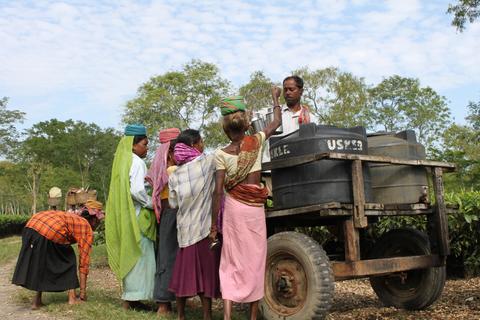
In India, it took a few more years to realize that the local workers in the factories, the textile mills, and the mines would also improve their efficiency if they were given the benefit of an afternoon break and a cup of tea. Patrons followed and tea consumption then developed rapidly.
This generated the introduction of a typically Indian cup, the spicy milk tea brew called masala chai, which quickly became part of the Indian way of life. Indeed, with the Indians’ innate sense for business, hundreds and then thousands of chai wallahs – small business operators – set up their street stalls for brewing and selling their masala chai from early morning to late in the night. In this way, chai has come to be sold on every street corner across India and is a symbol of hospitality, friendship, and connection.
types of Chai
As chai in the Western world has grown in popularity, we have begun to riff on traditional chai – innovating for health benefits, flavor and availability. Today, you can find masala blended with green tea, caffeine-free rooibos, yerba mate and even oolong on the grocery shelves today. Chai is considered a flavor and is found in recipes as an elevated alternative to the standard cinnamon. Popular chai recipes include everything from ice cream, bread, pies and other sweets. It’s even found in cocktails, liquors and beers.
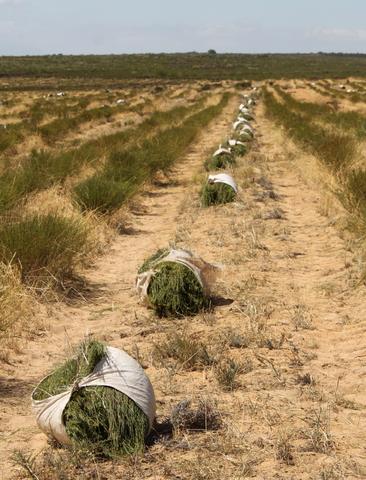

Loose Leaf Chai:
Our original loose-leaf chai blends are made by boiling the tea with water and milk and then adding sugar, any additional ingredients like vanilla, sea salt or fresh ginger, stirring and then straining. Many chai aficionados appreciate the loose-leaf version for a variety of reasons:
BENEFITS OF loose leaf CHAI:
Flexibility: You can add your sweetener of choice or create a sugar-free version. The concentrate is already brewed with raw, organic sugar, vanilla and a pinch of sea salt.
Economical: Each tin of loose-leaf chai makes over 20 cups of tea, a fantastic value! Concentrates make 6 12-ounce cups of chai each.
Storage: The loose-leaf blend maintains its freshness for up to a year. The concentrate must be consumed within a 6-month shelf life date.
Chai Concentrate:
Our slow-steeped and micro-brewed chai concentrates are bottles ready to use with tea, spices, sugar, vanilla and sea salt. Just add milk and heat, ice or create!
BENEFITS OF CHAI CONCENTRATE:
Convenience: Simply combine with equal parts milk and heat or ice! Sweet and simple!
Creativity: Chai concentrate can be used as a mixer for our Bourbon Chai Mule, Bourbon Milk Punch, and other recipes like Chai Fried Chicken! The only limit is your imagination!
What are some popular variations of chai?
Masala Chai
The traditional masala chai is made with black tea, sugar, a proprietary spice mix or masala and blended with milk. Inspired by an ancient recipe from Northern India, our masala chai (meaning spiced tea) has won the hearts and captured the tastebuds of Firepot devotees for almost two decades. Our exotic and aromatic spices are hand-blended and freshly ground for a uniquely vivid and balanced taste.
Dirty Chai
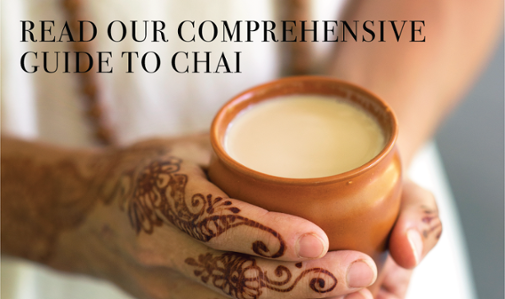
The addition of an espresso shot to a chai latte has been branded “dirty chai” like a Turkish coffee with tea, perfect for anyone who appreciates the allure of tea with the energetic boost of espresso.
Rooibos Chai
Rooibos Chai is a naturally decaffeinated version. It is made with a South African evergreen shrub known locally as “red bush” and is known for its high levels of antioxidants and its sweet, honeyed taste. Firepot Rooibos Chai is brewed with South Africa's mineral and nutrient-rich herb, making our popular chai recipe caffeine-free.
Chocolate Chai
Made with or without tea, cacao nibs can fill in for the base of this delicious drink, which is essentially spiced drinking chocolate. Chocolate and chai spice are a match made in heaven.
Yerba Mate Chai
Yerba Mate, Ilex Paraguariensis, is a traditional medicinal herb from South America known for enhancing stamina, detoxification and weight loss. Combined with our lively masala chai spices, it makes a fortifying and uplifting brew!
How to Make Chai At Home
In India, the traditional way of preparing chai was boiling a mixture of local milk (from a yak, buffalo, or cow) and water with loose black tea and spices, wrapped in a cloth for easy straining. There are various blends of spices, which vary according to local customs, personal inspiration and seasonal availability.
Of course, different milk options today include oat milk, almond milk, soy milk and more! You can enjoy your chai cold or hot, as a latte or with a dollop of honey. Chai is the perfect drink for crafting to fit your personality and mood.
From our Make It At Home video series, we'll demonstrate step-by-step how to make your favorite chai drinks at home:
1. Make It At Home: Firepot Chai Loose Leaf
2. Make It At Home: Masala Chai Latte from Concentrate
3. Make It At Home: Yerba Mate Chai
What Spices are in Chai?
Spices most commonly found in chai are those grown in India and Sri Lanka, where chai, as we know it in the West, comes from. Think cinnamon, cardamom, ginger, cloves and black peppercorns. Sometimes star anise nutmeg, allspice and turmeric are added too.
Click here to read our post about the spices in chai and their health benefits!
Chai Benefits
1. Clarity and Alertness
It can wake you up! Black tea leaves naturally contain caffeine and can give you lasting energy and focus of a cup of coffee without the jitters.
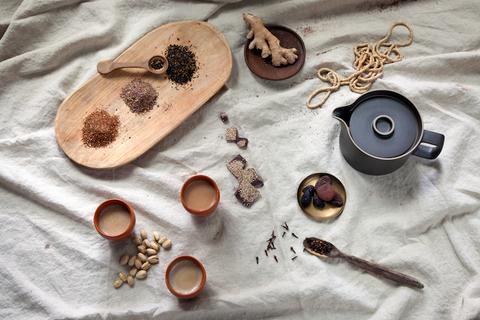
2. Helps Digestion
Can help with nausea relief! Ginger not only adds a little kick to your chai but also can help soothe an upset stomach and nausea.
3. Anti-inflammatory
Multiple studies have shown higher antioxidant levels and "flavonoids" within one hour of drinking tea. Research is ongoing, but it definitely packs a health punch! Ginger aids digestion by improving circulation and delivering oxygen to organs so they can perform optimally. Black pepper helps the pancreas produce digestive enzymes! (1, 2)
4. Ache and pain reliever
Clove has historically been used as a natural pain remedy, especially in toothaches!
Where to Buy Chai
With personal preference in mind, it’s fun to make your own chai at home using good-quality black tea and all of your favorite spices. This drink, though deeply rooted in tradition is easy to customize with your choice of milk, tea, spices and sweetener.
If you've never tasted chai before, I suggest ordering a chai latte at your local coffee shop or tea house and tasting what you like and don’t like about it! Maybe you’re not into cardamom but love cinnamon. It’s all about what tastes best to you!
Firepot Chai spices are hand-blended and freshly ground for a uniquely vivid and balanced taste. Firepot supports organic and Fair Trade practices and donates one percent of all sales to the empowerment of women and the preservation of wildlife in tea origins.
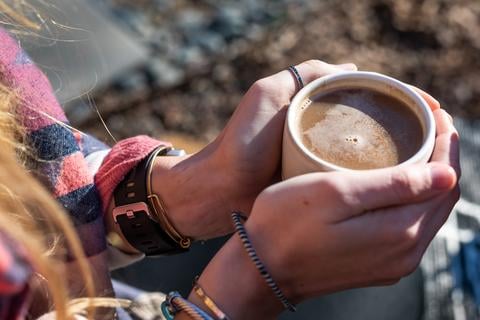
Firepot Masala Chai
Find Firepot's Masala Chai concentrate here.
See Firepot's Rooibos Chai concentrate here.
To see Firepot's Masala Chai loose-leaf, click here.
And for Firepot's Rooibos Chai loose-leaf, click here.
Download one of our favorite Chai Recipes:
Chocolate Chai
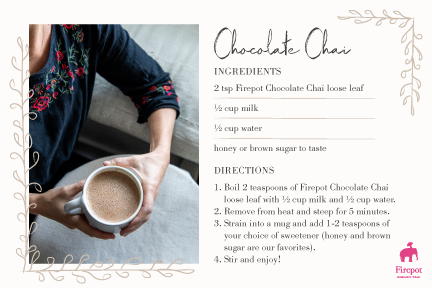
Interested in learning more about chai? What spices are in chai and what are the health benefits of each? How do I make a chai latte at home? What are the different types of tea used in chai? Check out our Comprehensive Guide to Chai for information, resources, chai recipes, demonstration videos, and more!
If you love the taste of chai, have you ever considered it in cooking or baking? The scent of chai bread baking is heavenly...and if you haven't tried our pumpkin scones with chai buttercream frosting...you're missing out. Download your free Chai Recipe Guide by clicking here or on the link below:







Leave a comment
Comments will be approved before showing up.